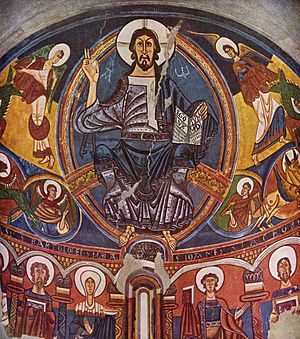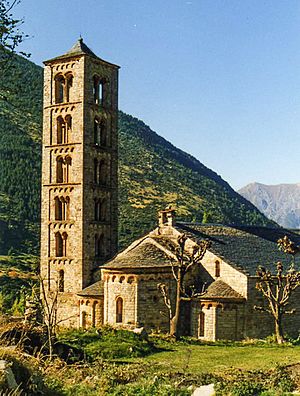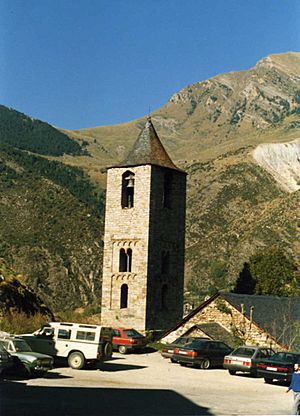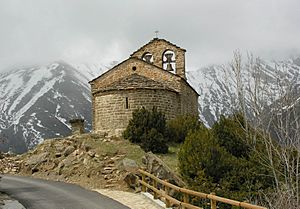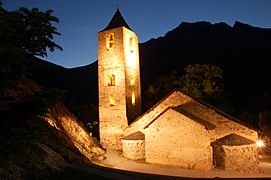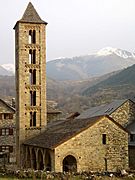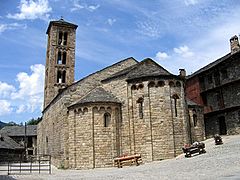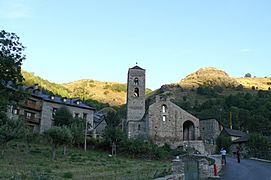Catalan Romanesque Churches of the Vall de Boí facts for kids
| UNESCO World Heritage Site | |
|---|---|
| Location | Vall de Boí, Alta Ribagorça, Province of Lleida, Catalonia, Spain |
| Includes | |
| Criteria | Cultural: (ii), (iv) |
| Inscription | 2000 (24th Session) |
| Area | 7.98 ha (19.7 acres) |
| Buffer zone | 3,562 ha (8,800 acres) |
The Churches of the Vall de Boí are a group of nine old churches in the Vall de Boí, a beautiful valley in Catalonia, Spain. These churches were built a long time ago, between the 11th and 12th centuries. They are famous for their amazing Romanesque art and architecture.
These churches are special because they show a very clear and beautiful example of a style called Lombard Romanesque. They were also known for the rich paintings inside them. Today, they hold the largest collection of Romanesque art in Europe. In the early 1900s, many of the original paintings were moved to the National Museum of Catalan Art (MNAC) in Barcelona to keep them safe. Copies were put in their place in the churches.
Contents
- History of the Amazing Frescoes
- The Churches: A World Heritage Site
- Sant Climent, Taüll: A Romanesque Masterpiece
- Santa Maria, Taüll: Another Important Church
- Sant Joan de Boí: Famous for Mythical Animals
- Santa Eulàlia d'Erill la Vall: A Tall Bell Tower
- Sant Feliu, Barruera: An Early Church
- La Nativitat, Durro: High in the Mountains
- Sant Quirc, Durro: A Simple Hermitage
- Santa Maria, Cardet: A Church on a Slope
- Santa Maria, Cóll: The Church of the Assumption
- Gallery
- See also
History of the Amazing Frescoes
The 1100s were a great time for painting frescoes in Catalonia. As the region became wealthier, more beautiful art was created. The churches in the Vall de Boí were built in two main periods. Some were built around 1100, and others, like those in Taüll, were built around 1123. The art in the apse of Sant Climent de Taüll is considered a masterpiece of European Romanesque painting.
In the early 1900s, people became very interested in the old wall paintings in the Vall de Boí churches. Scholars wanted to study them, and art dealers wanted to buy them. In 1904 and 1906, the Hiking Club of Catalonia visited the valley to take notes and photos. Later, in 1907, the Institute for Catalan Studies also explored the area, documenting the important buildings and artworks.
After these studies, copies of the Pyrenean frescoes were made. This made many museums and private collectors want to own the original artworks. By 1919, many of these artworks were being bought and sold, often ending up in museums in the United States. In one case, a collector tried to remove frescoes from a church to sell them.
However, the people of Taüll refused to let their church frescoes leave. They fought to keep the art in their community. This led to an agreement that the frescoes would be moved to the National Museum of Catalan Art (MNAC) in Barcelona. This way, they would be safe from theft or unfair sales. A team of Italian experts carefully removed the paintings from the walls. In some cases, they put copies back in the churches.
The Romanesque paintings from Taüll that are now in the MNAC are famous worldwide. Experts continue to study all the remaining Romanesque murals from the Vall de Boí area. Most of these are now safely kept at the MNAC in Barcelona and at the Museum of Vic.
The Churches: A World Heritage Site
UNESCO is an organization that helps protect important places around the world. In 2000, UNESCO named nine churches in the Vall de Boí as World Heritage Sites. This means they are very important to human history and should be protected.
Here are the nine churches:
| Code | Name | Place | Coordinates |
|---|---|---|---|
| 988–001 | Sant Feliu de Barruera | Barruera | 42°30′17.2″N 0°48′13.1″E / 42.504778°N 0.803639°E |
| 988–002 | Sant Joan de Boí | Boí | 42°31′41.7″N 0°50′01.0″E / 42.528250°N 0.833611°E |
| 988–003 | Santa Maria de Taüll | Taüll | 42°31′01.4″N 0°51′03.4″E / 42.517056°N 0.850944°E |
| 988–004 | Sant Climent de Taüll | Taüll | 42°30′59.6″N 0°50′59.4″E / 42.516556°N 0.849833°E |
| 988–005 | Santa Maria de Cóll | Cóll | 42°26′35.3″N 0°44′43.9″E / 42.443139°N 0.745528°E |
| 988–006 | Santa Maria de Cardet | Cardet | 42°29′03.8″N 0°46′36.3″E / 42.484389°N 0.776750°E |
| 988–007 | La Nativitat de Durro | Durro | 42°30′09.9″N 0°49′19.1″E / 42.502750°N 0.821972°E |
| 988–008 | Sant Quirc de Durro | Durro | 42°30′08.6″N 0°49′25.3″E / 42.502389°N 0.823694°E |
| 988–009 | Santa Eulàlia d'Erill la Vall | Erill la Vall | 42°31′49.6″N 0°49′55.8″E / 42.530444°N 0.832167°E |
Sant Climent, Taüll: A Romanesque Masterpiece
The church of Sant Climent de Taüll was officially opened on December 10, 1123. It is the biggest and best-kept church in the Vall de Boí. It is a symbol of Catalan Romanesque architecture because of its beautiful inside decorations and its Lombard Romanesque style.
This church has a main hall with three long sections called naves. These sections are separated by round columns. At the end, there are three half-circle shaped parts called apses. The roof is made of wood. Next to the church, there is a tall, six-story bell tower.
The main door is on the south side and has an arch shape. Inside, there were many frescoes painted by an unknown artist called the Master of Taüll. The painting of Christ Pantocrator in the apse is now at the Museu Nacional d'Art de Catalunya (MNAC). It is one of the best examples of Romanesque art in Europe.
Santa Maria, Taüll: Another Important Church
Santa Maria was also opened in 1123. For many years, it was the main church for the town of Taüll. Its design is very similar to Sant Climent. It also has three naves and three apses. The bell tower is in the middle of the church.
Many of the church's frescoes were studied in 1907 by Josep Puig i Cadafalch. A very important fresco shows Saint Mary with her child. This painting is now kept safe at the MNAC.
Sant Joan de Boí: Famous for Mythical Animals
Sant Joan is another church with three naves. Its original roof was made of wood, but it was later changed to stone. The bell tower is in the clear Lombard style and is attached to the side of the church. Only two of its original levels are still there, as the top part was added later.
This church has a great collection of 12th-century paintings. Some of the most interesting ones show different mythical animals. The original paintings, called the Paintings from Sant Joan in Boí, are at the MNAC. You can see copies of them in the church today.
Santa Eulàlia d'Erill la Vall: A Tall Bell Tower
Santa Eulàlia was named a Spanish Monument of historical and cultural interest in 1962. The church has one main section (a single nave) and a half-circle apse. On the outside, there is a porch with round columns. The bell tower is a great example of Lombard architecture in the Vall de Boí. It is 23 meters tall and has six stories. It is decorated with double windows that frame the arches.
Inside the church's sacristy, a 12th-century sculpture group called El Davallament was found. This sculpture is now split into two parts: one is at the MNAC, and the other is at the Episcopal Museum of Vic.
Sant Feliu, Barruera: An Early Church
Sant Feliu was first mentioned in documents in the late 1200s. Not much is known about its early history. It is located in the town of Barruera. It has a single nave with a rounded ceiling called a barrel vault. The nave ends in a semicircular apse.
La Nativitat, Durro: High in the Mountains
This church is located high up at 1,386 meters in the small town of Durro. It was first mentioned in the 11th century. Its style is very similar to the other churches. It has a single nave and a single apse. Its five-story bell tower has very few windows.
Sant Quirc, Durro: A Simple Hermitage
Sant Quirc is a small, simple hermitage. A hermitage is a small church or chapel, often in a quiet place. The main part of the church has a rounded ceiling and ends in a presbytery, which is a bit higher than the rest of the room. The entrance door has an arch with special wedge-shaped stones called voussoirs. The hermitage is not very bright inside, with only a small round window at the end and tiny openings on the west side.
Santa Maria, Cardet: A Church on a Slope
This is a small church with one nave. It has a special ceiling called a grain vault, divided into four sections. Because it is built on a slope, the apse, which has two floors, is higher than the main nave. There is also a crypt (an underground room) in the basement of the apse.
Santa Maria, Cóll: The Church of the Assumption
Also known as the church of the Assumption, Santa Maria has a single nave with a barrel vault ceiling. The bell tower is square and has two floors. The first floor has pointed windows, and the second floor holds the bells. It is believed to have been built around the mid-1200s.
Gallery
See also
 In Spanish: Iglesias románicas del Valle de Bohí para niños
In Spanish: Iglesias románicas del Valle de Bohí para niños
- Romanesque architecture in Spain
- Spanish Romanesque
- List of regional characteristics of Romanesque churches


